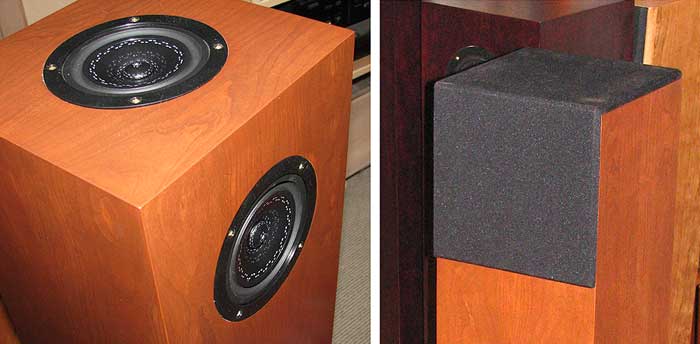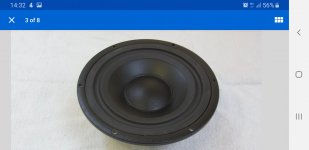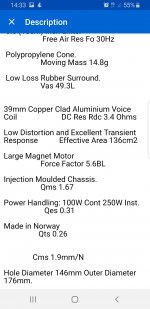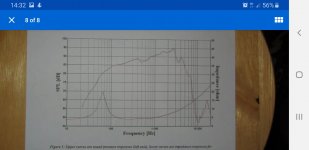I have 4 off Seas 6.5" 4ohm polypropylene that I fancy doing a little project with. 1 on the front, 1 on the rear and wired in phase at 8 ohm. (So far so good ?!)
They aren't the greatest at the higher frequencies so will be doing a WAW style build crossing low to a full range of some description.
Now if I sim 1 driver in a given volume box I get the roll off at a given point. If I put 2 drivers in the same volume the roll off is earlier. I am loosing LF output.
Here is my question. Assuming winisd doesn't take into account any baffle step losses ...which we know it can't....Will I regain LF extension due to the rear driver cancelling the baffle loss.? So I actually will get (in a perfect scenario) the LF extension as winisd shows me for one driver.?
Thanks
They aren't the greatest at the higher frequencies so will be doing a WAW style build crossing low to a full range of some description.
Now if I sim 1 driver in a given volume box I get the roll off at a given point. If I put 2 drivers in the same volume the roll off is earlier. I am loosing LF output.
Here is my question. Assuming winisd doesn't take into account any baffle step losses ...which we know it can't....Will I regain LF extension due to the rear driver cancelling the baffle loss.? So I actually will get (in a perfect scenario) the LF extension as winisd shows me for one driver.?
Thanks
Seas 6.5" 4ohm polypropylene
Which one? Data?
If you are crossing that low you might find mounting them push-push on the sides is better (no bipole dip) but if you adjust the baffle width to push the bipole dip above the XO you will be OK.
The situation were a bipole eliminates any BS artifacts is when they are mounted on the sides wrt how you are facing the box. Front/back causes a bipole dip as well as no issues with BS.
dave
Thanks for the input Dave. They are proprietary OEM drivers made by Seas for some speaker company that folded many moons ago. Shame. But they were cheap and so I grabbed 4 of them.
My baffle width would be 250mm wide. Maybe I'd use that little peak and dip 400 to 500Hz as an XO starting point.? Manufactures FR graphs obviously, I havent measured them myself
My baffle width would be 250mm wide. Maybe I'd use that little peak and dip 400 to 500Hz as an XO starting point.? Manufactures FR graphs obviously, I havent measured them myself
Attachments
Last edited:
You have more info than i did with the 20 similar drivers i scored made for PSB.
250 mm implies an approximate BS(-3) of 460 Hz, which by itself suggest an XO between 325 Hz and 460 Hz (i tend towards the lower number). The bipole dip is related to the difference between the distanc of the front driver & the back driver. Half the width plus the depth of the box are used to figure out exactly where the dip comes.
I’ll have a look at the drivers.
dave
250 mm implies an approximate BS(-3) of 460 Hz, which by itself suggest an XO between 325 Hz and 460 Hz (i tend towards the lower number). The bipole dip is related to the difference between the distanc of the front driver & the back driver. Half the width plus the depth of the box are used to figure out exactly where the dip comes.
I’ll have a look at the drivers.
dave
Thankyou Dave I would be very interested to hear your thoughts.
This will be a passively filtered project BTW and I have WAF to consider so will probably be a max of say 15 to 17 litre enclosure.
This will be a passively filtered project BTW and I have WAF to consider so will probably be a max of say 15 to 17 litre enclosure.
1st off, miniOnken alignment (needs a hi R slot vent). 25 litres about optimum for 2, F10 about 40. Reducing the box to 16 litre means 5 hz higher F10.
dave
dave
I should also say that looking at the Qt when i was inputting the data i did not expect them to go as low as they do.
If you paid anywhere what i did for mine a real steal i expect.
dave
If you paid anywhere what i did for mine a real steal i expect.
dave
The answer is no.
If you look at it one way, you have the same distribution of bass whether you use one driver or four. On the other hand you now have more upper midrange around the box, unless you cross (equalise) that, taking you back to where you started.
If you look at it one way, you have the same distribution of bass whether you use one driver or four. On the other hand you now have more upper midrange around the box, unless you cross (equalise) that, taking you back to where you started.
Assumming Allen is sayin gno to you initial inquiry, i have to disagree. Bipole is a method to make rom response similar to on axis. It is a recognized methd of BSC. One does have to worry abou tthe bipole dip. If you rotate the cabinet 90° so the bass drivers are on the side, it becomes near perfect, but you are listening to the HF on the bass drivers 90° off-axis, potentially a good thing when it comes to XO low.
I should probably updat ethe article a bit, but it is still useful. Baffle Diffraction Step
The next article is more specific on the same subject.
dave
I should probably updat ethe article a bit, but it is still useful. Baffle Diffraction Step
The next article is more specific on the same subject.
dave
It was this part.
What you have with opposing drivers is all sound going all around. You now have more midrange, relatively speaking. If you then equalise the second woofer so it is purely acting to compensate the baffle, you now have the same radiation pattern at all frequencies and the same on-axis response as the single driver case.
The reason is that it depends primarily on the baffle/cabinet, and not the drivers. The frequency at which this happens is related to the baffle/cabinet dimensions.
What you will have with one driver, after mounting and equalising, is bass radiating all around, and midrange going forward mostly according to the baffle.jimk04 said:Will I regain LF extension due to the rear driver cancelling the baffle
What you have with opposing drivers is all sound going all around. You now have more midrange, relatively speaking. If you then equalise the second woofer so it is purely acting to compensate the baffle, you now have the same radiation pattern at all frequencies and the same on-axis response as the single driver case.
The reason is that it depends primarily on the baffle/cabinet, and not the drivers. The frequency at which this happens is related to the baffle/cabinet dimensions.
You can see that at no point is any energy 'lost' to the room.baffle loss
Now i understand Allen’s answer. Rolling off the back driver below BS is often suggestted if the extra midrange radiation causes issues.
For bass we like push-push on the sides like Tysen V2, if you are bipoling a FR mounting the 2nd driver on the top instead of back proved to be more room freindly with that extra top-mid reflecting off the ceiling instead of the back wall. Often the top panel slopped 10-15° up at the back so the top driver is firing slighly forward.
The so-called castle arrangement (since Castle did some commercial loudspeakers that did just this.

dave
For bass we like push-push on the sides like Tysen V2, if you are bipoling a FR mounting the 2nd driver on the top instead of back proved to be more room freindly with that extra top-mid reflecting off the ceiling instead of the back wall. Often the top panel slopped 10-15° up at the back so the top driver is firing slighly forward.
The so-called castle arrangement (since Castle did some commercial loudspeakers that did just this.
dave
You can see that at no point is any energy 'lost' to the room.
A good point. Baffle Step Compensation is a can of worms. Typically used to bring up the on-axis level ogf the lower frequencies every dB of BSC means that the power/room response is now 1 dB higher. Too much and the excess power response yields less than perfect response.
But it is the case that many people like the bass exageratted.
dave
Thanks for all this guys. Very interesting and I am learning.
Dave I paid £25 GBP each driver so yes pretty cheap for a cast basket driver I thought. I shall have a look at mini onken. I am aware of it obviously.
My intention was to bipolar the bass alone....with 2 of the Seas 6.5. And then use a full range for the rest. Maybe I complicate things and should just try 1 of the 6.5 initially. One caveat is my speakers are well close to the wall. It isbt a flat wall....curtains., shelves, etc....so a bit to help break up any reflections. But far from ideal. So maybe the side firing bipolar would be better than front/ rear.
I shall post up my simple Winisd sims later interest
I won't be EQ ing or bi amping. Unfortunately when we decorated the room I buried 2 core cables under the carpets.....mistake...should have put 4 core in there! I fully appreciate the inductors could be 'sizeable.'
Dave I paid £25 GBP each driver so yes pretty cheap for a cast basket driver I thought. I shall have a look at mini onken. I am aware of it obviously.
My intention was to bipolar the bass alone....with 2 of the Seas 6.5. And then use a full range for the rest. Maybe I complicate things and should just try 1 of the 6.5 initially. One caveat is my speakers are well close to the wall. It isbt a flat wall....curtains., shelves, etc....so a bit to help break up any reflections. But far from ideal. So maybe the side firing bipolar would be better than front/ rear.
I shall post up my simple Winisd sims later interest
I won't be EQ ing or bi amping. Unfortunately when we decorated the room I buried 2 core cables under the carpets.....mistake...should have put 4 core in there! I fully appreciate the inductors could be 'sizeable.'
Last edited:
A decent price, way mor ethan i paid thou.
If you have them i’d use 2. 2 works really well in the bass. Push-push gives. hugr reduction in box load.
dave
If you have them i’d use 2. 2 works really well in the bass. Push-push gives. hugr reduction in box load.
dave
- Home
- Loudspeakers
- Full Range
- Push push bipole..front and rear mounted....enclosure size



